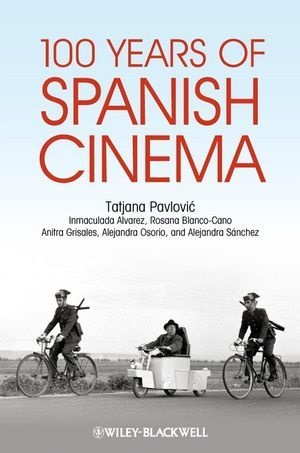Read more
Informationen zum Autor Tatjana Pavlovic is Associate Professor of Spanish at Tulane University in New Orleans.Inmaculada Alvàrez is a Visiting Assistant Professor at University of California, Riverside.Rosana Blanco-Cano is Assistant Professor at Trinity University in San Antonio, Texas.Anitra Grisales is a freelance editor and translator specializing in film and media studies.Alejandra Osorio is a professor in the Communications Department of the Universidad Autónoma Metropolitana-Cuajimalpa, Mexico.Alejandra Sánchez is a Ph.D. candidate at Tulane University in the Department of Spanish and Portuguese. Klappentext 100 Years of Spanish Cinema provides an in-depth look at the most important movements, films, and directors of twentieth-century Spain from the silent era to the present day. Approaching film as a cultural institution and a technological invention, it combines aesthetic analysis with contextual information on Spanish history, politics, and the cinematic industry. 100 Years of Spanish Cinema offers a step-by-step guide for students as they explore the visual elements, critical perspectives, and cultural contexts of twenty-two featured works, helping them to be more analytical, sophisticated, and engaged spectators, while also enabling them to interpret and examine the films in light of the socio-cultural conditions in which they were produced. Zusammenfassung From the silent era to the present day, 100 Years of Spanish Cinema provides an in-depth look at the most important movements, films, and directors in twentieth-century Spain. Inhaltsverzeichnis List of Figures.About the Authors.Acknowledgments.Preface.1. Silent Cinema and its Pioneers (1906-1930).El ciego de aldea, Ángel García Cardona.Amor que mata, Fructuós Gelabert.Don Pedro el Cruel, Ricardo Baños, Albert Marro.La aldea maldita, Florián Rey.2. Surrealism (1924-1930) and the Advent of Sound (the Second Republic: 1931-1936).Un chien andalou, Luis Buñuel.Tierra sin pan, Luis Buñuel.3. Spanish Civil War (1936-1939).Suspiros de España, Benito Perojo.Canciones para después de una guerra, Basilio Martín Patino.4. The Autarky: Papier-Mâché Cinema (1939-1950).Raza, José Luis Sáenz de Heredia.Locura de amor, Juan de Orduña.5. Neorealism: Status Quo and Dissent (1951-1961).El cochecito, Marco Ferreri.Viridiana, Luis Buñuel.6. The "Liberal" Dictatorship and its Agony (1962-1975).El verdugo, Luis García Berlanga.El jardín de las delicias, Carlos Saura.7. Cinema of the Transition: The Period of Disenchantment (1975-1979).El desencanto, Jaime Chávarri.El crimen de Cuenca, Pilar Miró.8. Post-Franco Spain: The Pedro Almodóvar Phenomenon (1980-1991).Pepi, Luci, Bom, y otras chicas del montón, Pedro Almodóvar.¿Qué he hecho yo para merecer esto!, Pedro Almodóvar.9. Contemporary Trends (1992 to the Present).Vacas, Julio Medem.Carícies, Ventura Pons.Flores de otro mundo, Icíar Bollaín.The Secret Life of Words (La vida secreta de las palabras),Isabel Coixet.Glossary of Film Terms.Historical Chronology.Notes.Bibliography.Index...
List of contents
List of Figures.
About the Authors.
Acknowledgments.
Preface.
1. Silent Cinema and its Pioneers (1906-1930).
El ciego de aldea, Ángel García Cardona.
Amor que mata, Fructuós Gelabert.
Don Pedro el Cruel, Ricardo Baños, Albert Marro.
La aldea maldita, Florián Rey.
2. Surrealism (1924-1930) and the Advent of Sound (the Second Republic: 1931-1936).
Un chien andalou, Luis Buñuel.
Tierra sin pan, Luis Buñuel.
3. Spanish Civil War (1936-1939).
Suspiros de España, Benito Perojo.
Canciones para después de una guerra, Basilio Martín Patino.
4. The Autarky: Papier-Mâché Cinema (1939-1950).
Raza, José Luis Sáenz de Heredia.
Locura de amor, Juan de Orduña.
5. Neorealism: Status Quo and Dissent (1951-1961).
El cochecito, Marco Ferreri.
Viridiana, Luis Buñuel.
6. The "Liberal" Dictatorship and its Agony (1962-1975).
El verdugo, Luis García Berlanga.
El jardín de las delicias, Carlos Saura.
7. Cinema of the Transition: The Period of Disenchantment (1975-1979).
El desencanto, Jaime Chávarri.
El crimen de Cuenca, Pilar Miró.
8. Post-Franco Spain: The Pedro Almodóvar Phenomenon (1980-1991).
Pepi, Luci, Bom, y otras chicas del montón, Pedro Almodóvar.
¿Qué he hecho yo para merecer esto!, Pedro Almodóvar.
9. Contemporary Trends (1992 to the Present).
Vacas, Julio Medem.
Carícies, Ventura Pons.
Flores de otro mundo, Icíar Bollaín.
The Secret Life of Words (La vida secreta de las palabras),Isabel Coixet.
Glossary of Film Terms.
Historical Chronology.
Notes.
Bibliography.
Index
Report
"However, 100 Years of Spanish Cinema is a much needed and comprehensive survey of Spanish cinema, and provides enough information on the history and context of this national cinema to encourage further inquiry and in fact, encourages the use of the book as a springboard for future reading." (Scope Book Reviews, 1 February 2011)
"An excellent resource for students of Spanish film and/or contemporary Spanish culture. Summing Up: Highly recommended." (Choice Reviews, May 2009)

